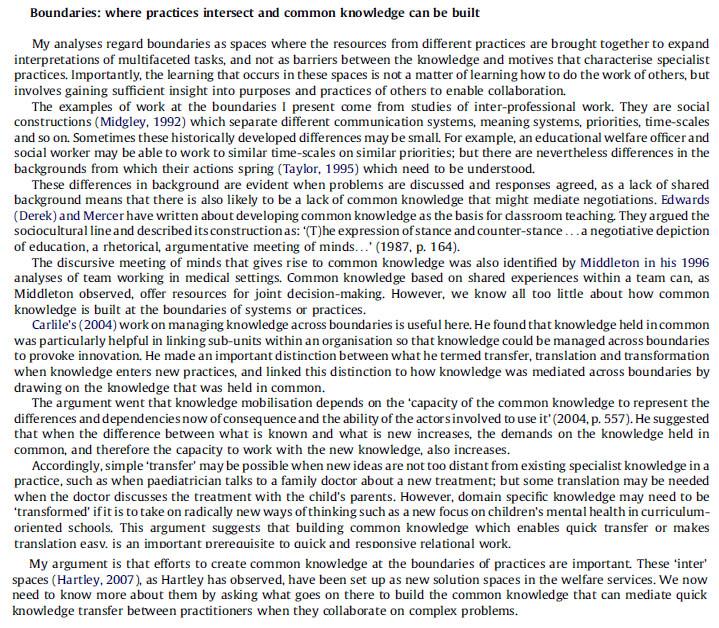Home /
Expert Answers /
Psychology /
briefly-summarise-main-points-from-the-content-provided-below-to-demonstrate-your-understanding-of-c-pa177
(Solved): Briefly summarise main points from the content provided below to demonstrate your understanding of c ...
Briefly summarise main points from the content provided below to demonstrate your understanding of common knowledge and how it can be built.
Boundaries: where practices intersect and common knowledge can be built My analyses regard boundaries as spaces where the resources from different practices are brought together to expand interpretations of multifaceted tasks, and not as barriers between the knowledge and motives that characterise specialist practices. Importantly, the learning that occurs in these spaces is not a matter of learning how to do the work of others, but involves gaining sufficient insight into purposes and practices of others to enable collaboration. The examples of work at the boundaries I present come from studies of inter-professional work. They are social constructions (Midgley, 1992) which separate different communication systems, meaning systems, priorities, time-scales and so on. Sometimes these historically developed differences may be small. For example, an educational welfare officer and social worker may be able to work to similar time-scales on similar priorities; but there are nevertheless differences in the backgrounds from which their actions spring (Taylor, 1995) which need to be understood. These differences in background are evident when problems are discussed and responses agreed, as a lack of shared background means that there is also likely to be a lack of common knowledge that might mediate negotiations. Edwards (Derek) and Mercer have written about developing common knowledge as the basis for dassroom teaching. They argued the sociocultural line and described its construction as: '(T)he expression of stance and counter-stance... a negotiative depiction of education, a rhetorical, argumentative meeting of minds...' (1987, p. 164). The discursive meeting of minds that gives rise to common knowledge was also identified by Middleton in his 1996 analyses of team working in medical settings. Common knowledge based on shared experiences within a team can, as Middleton observed, offer resources for joint decision-making. However, we know all too little about how common knowledge is built at the boundaries of systems or practices. Carlile's (2004) work on managing knowledge across boundaries is useful here. He found that knowledge held in common was particularly helpful in linking sub-units within an organisation so that knowledge could be managed across boundaries to provoke innovation. He made an important distinction between what he termed transfer, translation and transformation when knowledge enters new practices, and linked this distinction to how knowledge was mediated across boundaries by drawing on the knowledge that was held in common. The argument went that knowledge mobilisation depends on the 'capacity of the common knowledge to represent the differences and dependenciesnow of consequence and the ability of the actors involved to use it' (2004, p. 557). He suggested that when the difference between what is known and what is new increases, the demands on the knowledge held in common, and therefore the capacity to work with the new knowledge, also increases. Accordingly, simple 'transfer' may be possible when new ideas are not too distant from existing specialist knowledge in a practice, such as when paediatrician talks to a family doctor about a new treatment; but some translation may be needed when the doctor discusses the treatment with the child's parents. However, domain specific knowledge may need to be 'transformed' if it is to take on radically new ways of thinking such as a new focus on children's mental health in curriculumoriented schools. This argument suggests that building common knowledge which enables quick transfer or makes translation easv. is an important prerequisite to auick and responsive relational work. My argument is that efforts to create common knowledge at the boundaries of practices are important. These 'inter' spaces (Hartley, 2007), as Hartley has observed, have been set up as new solution spaces in the welfare services. We now need to know more about them by asking what goes on there to build the common knowledge that can mediate quick knowledge transfer between practitioners when they collaborate on complex problems.
Expert Answer
Demonstration. In my studies, boundaries are not seen as barriers between the knowledge and motivations that distinguish specialised activities, but rather as places where resources from many practises can be brought together to extend interpretation
